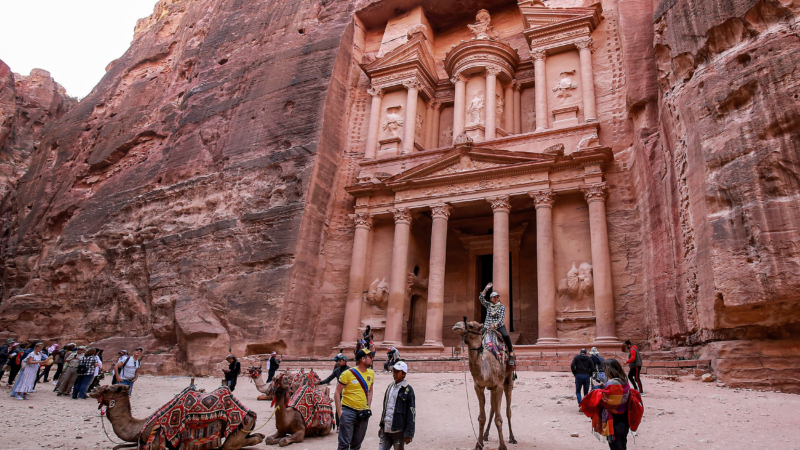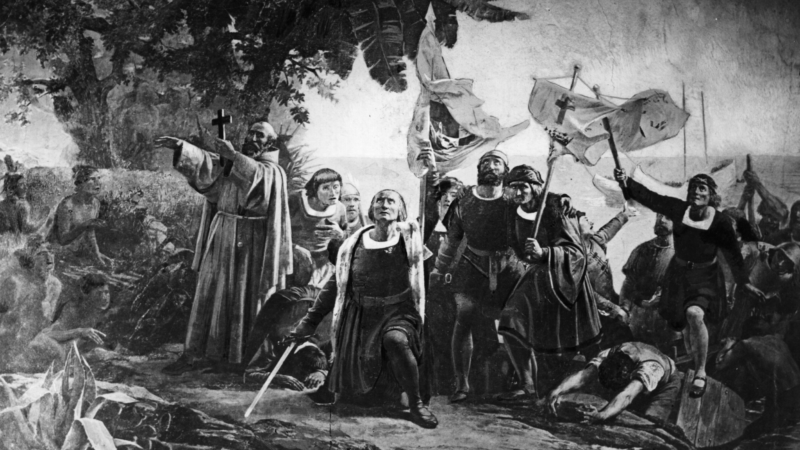Archaeologists discover 12 skeletons at a buried tomb in Petra, Jordan
Archaeologists say they’ve made a remarkable discovery in a place already known for its rich ancient history: 12 full skeletons in a tomb beneath one of Jordan’s biggest tourist attractions.
The remains were found beneath the Treasury, also called Al Khazneh, in the ancient city of Petra — famous as a landmark seen in the movie Indiana Jones and the Last Crusade.
The Treasury, believed to be a mausoleum, was carved by the Nabataean people around 2,000 years ago. Petra was the capital of the Nabataeans, who carved many elaborate structures out of rose-colored rock. The city is now a UNESCO World Heritage site.
Richard Bates, a professor of geophysics at the University of St Andrews in Scotland who was part of the archaeological team, said the discovery will help researchers learn more about the ancient people.
“If you look at all the other tombs in the Petra area, only a few have ever contained any human remains, and those are very fragmentary, whereas this has got 12 complete bodies within it,” he told NPR.
Bates said the discovery not only sheds light on the rituals involved in Nabataean birth and death practices, but also, “by analyzing the skeleton material, the teeth, the bones, we can tell things about their lifestyle. So it’s going to unlock a view on Nabataean life that we’ve just never had access to before.”
A local archaeological team obtained the rare permission to get inside the Treasury building. Bates ran ground-penetrating radar as part of the team. “That’s when we discovered the signals which I interpreted as voids in the subsurface,” he said.

The new chamber is about 18 feet by 18 feet and 9 feet tall, he estimates, and preliminary dating puts it from around the first century B.C. to the first century A.D., in the middle of the Nabataean Kingdom. The civilization existed from roughly the 4th century B.C. until it was annexed by the Romans in 106 A.D.
Archaeologists had already discovered indications of this tomb around 2003, but the dig site was shut down over lack of funding at the time, Bates said. Separate tombs were discovered at the Treasury in 2004, according to Petra’s tourism authority, which says they were royal tombs.
The tomb’s discovery happened over the summer but is now being publicized as part of the show Expedition Unknown on the Discovery Channel.

In a coincidence, the crew also found that one skeleton was holding a ceramic vessel similar to a famous chalice seen in the Indiana Jones movie.
Archaeologist Pearce Paul Creasman of the American Center of Research, who led the team, said in a press statement that mysteries still remain about the Treasury. “When was this remarkable structure built, and why? Little did we know that this dig might completely change what we know about The Treasury and help solve the mysteries of the Nabataean people.”
In an email to NPR, Creasman also credits the work of the project’s co-directors: Fadi Bala’awi, the director general of Jordan’s Ministry of Tourism and Antiquities; and Fares Braizat, the chief commissioner of the Petra Development and Tourism Region Authority.
What happens next for the project comes down to funding.
“The next step for this set of discoveries is to get the money to properly exhume at least one of the bodies and do a full study on it,” Bates said, with the goal of examining all the bodies.
“There are indications from the geophysics that there are other tombs there. … A lot of where we go from here is going to be quite expensive, basically. So who knows when that’s going to happen?”
‘Cheat Code to Life’: Jailhouse lawyers help incarcerated people—and themselves, too
A new trove of letters and oral histories is shining a light on the successes and challenges of jailhouse lawyers: people in prison who help themselves and others navigate the legal system.
Hakeem Jeffries could be the first Black speaker of the House. First, he needs to win
House Minority Leader Hakeem Jeffries is campaigning in competitive districts across the U.S. with the goal of flipping control of the House of Representatives in the November election.
Swing state map: Polls move in Trump’s direction, but the race remains tight
The polling averages show Vice President Kamala Harris’ lead has dropped in every swing state in recent weeks.
Christopher Columbus may have been a Spanish Jew, according to a new documentary
A recently televised documentary in Spain rekindles competing versions of the famed explorer's origins, but the scientific community is viewing it with caution.
Small business disaster loan program is out of money until new funds are approved
The SBA’s disaster loan program has run out of money, it announced on Tuesday. The agency expects to receive new funding from Congress, and will continue to accept applications in the meantime.
In Michigan, Arab Americans weigh the power of a vote
We travel to the swing state of Michigan — in order to speak to some of the most influential and misunderstood voters in the country: Arab Americans in Dearborn. The Dearbornites we met said that the war in Gaza is the key issue on their minds as they consider how to cast their ballots. What these voters ultimately decide could have huge consequences for the whole country.



